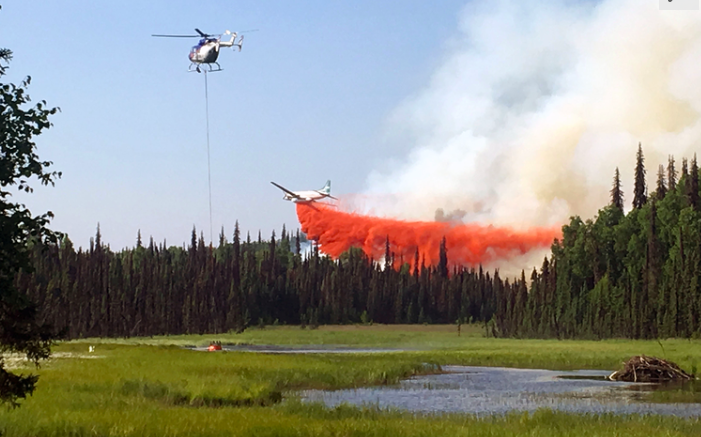
Air tanker drops a load of retardant on the Malaspina Fire in Alaska. Photo: Ed Soto, Alaska Division of Forestry
By Alexandra Patel
Extreme temperatures in Alaska are causing an outbreak of explosive wildfires throughout the state, with Fairbanks, Anchorage experiencing its warmest March to date, as reported recently by Our Daily Planet. Just in the week of July 3rd, more than 600,000 acres of lands burned – doubling the year-to-date burn total which now sits at 1.28 million acres. By the end of the year, it is estimated that 2 to 3 million acres will have been engulfed in flames. Fires are not only getting more frequent, but increasingly bigger and harder to contain. In Anchorage, the Hess Creek fire is now the largest fire in the U.S. at over 149,000 acres.
Why This Matters: Rapid warming has set a vicious cycle in motion, where rising global temperatures spark larger and longer fires across the Arctic Circle and the resultant clouds of smoke emit even more CO2 into the atmosphere. According to Thomas Smith, professor of geography at the London School of Economics, “The amount of CO2 emitted from Arctic Circle fires in June 2019 is larger than all of the CO2 released from Arctic Circle fires in the same month from 2010 through to 2018 put together.” Not only is the rise in wildfire incidence a negative consequence the climate crisis – it is also actively making it worse. As the situation escalates, fires will emerge with increasing frequency in places not used to dealing with these threats – such as the wildfires in Germany last summer brought on by Europe’s heatwave and drought. By mid-century, it is projected that the number of days conducive to extreme fires will increase by 20 to 50 percent globally.
The Arctic Circle is Blazing: This is not an isolated incident, but a worldwide phenomenon caused by rapid warming.
- All across the Arctic Circle, there has been an eruption of wildfires which scientists are calling “unprecedented” due to the high latitudes and timing in year.
- On July 10th, Greenland was set ablaze for the first time in two years, demonstrating just how high the risk is even in a place where there “simply aren’t that many precedents for wildfires.”
- According to several studies, fires are moving farther north to the Arctic, are burning at more intense rates and are beginning earlier on in the year. This is in accordance with many climate models that have predicted the impacts of melting sea ice and rising ocean and air temperatures.
- More than any other place on the planet, the Arctic is heating up the fastest and this is having a devastating effect on its environment as rampant flames slowly but surely consume the region.
Hazardous to Health: Massive amounts of smoke accumulating from the wildfires are posing a serious health threat to the surrounding areas. Concentrations of particle matter in the air have reached dangerous levels, as one air quality station recorded readings for particulate matter over 700 – anything greater than 250 is designated as hazardous.


